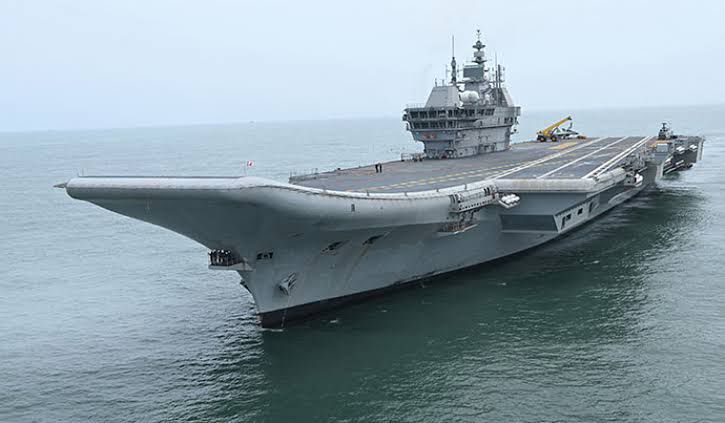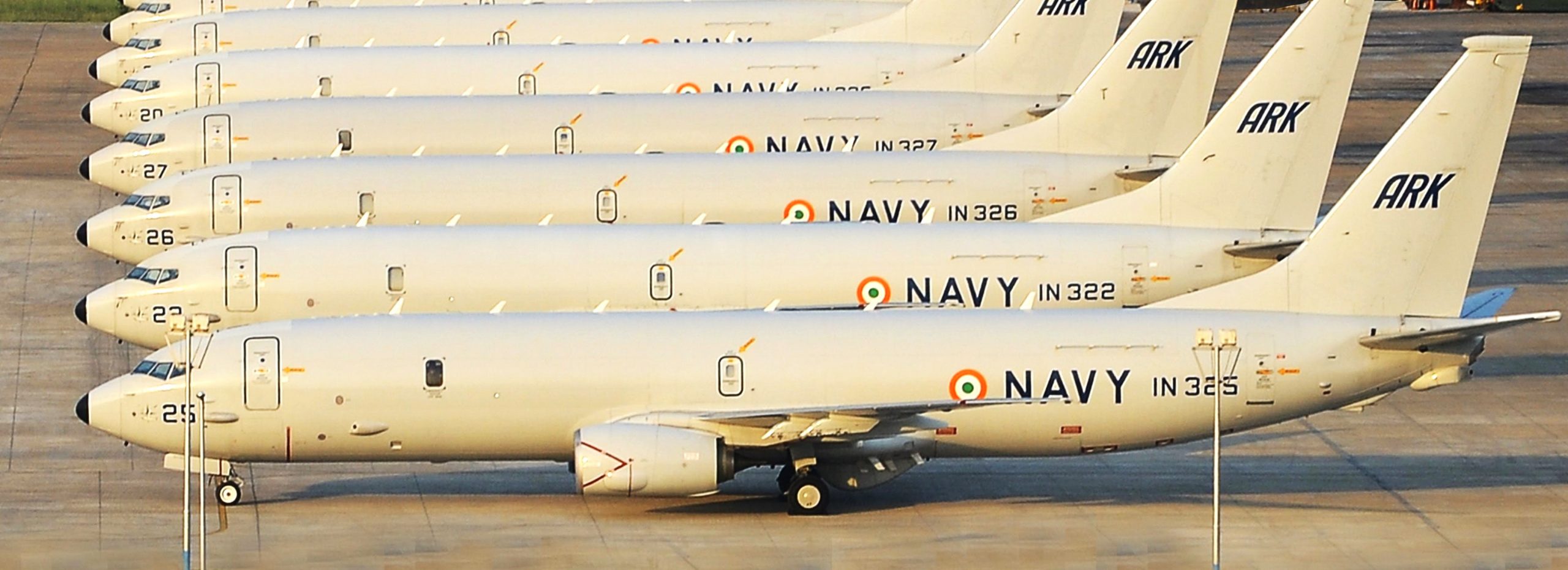
India Needs Large Aircraft Carriers

The recent public statement by the serving Naval chief that the navy hopes to place a repeat order on Cochin Shipyard for another Vikrant class is only partly encouraging. Partly because India needs another carrier; disappointing because it will be only of 40000 tons. A 40000 tons carrier will embark about 25 aircraft which will certainly dominate the seas around the fleet, but fail to ‘project’ Indian power, trans-continently. In other words, the Vikrant class of carrier will suffice for air domination, but not for power projection. Why is power projection imperative? That question can best be answered only by another question. What should the armed forces of the world’s third most powerful nation look like?
While one cannot go into all the details, the broad particulars are clear. An army of one million, three hundred thousand soldiers, to protect territorial integrity would be a complete waste of money. The very term ‘third most powerful country’ envisages a regional power, applying its power through theater commands in and around the Indian ocean, West Asia, SE Asia and the Malacca Straits. The backbone of these theaters will rest on a power projection Navy and expeditionary air forces. In any case, having the fourth largest air force whose primary task is defending territorial air space only, is an absurd waste of resources. The armed forces of the world’s third most powerful nation must be an outward looking, power projecting force that influences India’s diplomatic outreach in the Indian ocean littoral, West Asia, and South-East Asia.
To achieve this, we need overseas airbases in probably Great Nicobar, to dominate the Malacca Straits and in Masirah (Oman) to dominate the Persian Gulf, the Gulf of Aden and suppress the Chinese base in Djibouti. The air power will be backed by the naval air arm operating from two power projection carriers of roughly 80,000 tons, embarking roughly 70 to 80 aircraft each. The air component would consist of 48 fighter /ground attack, five air early warning aircraft, three electronic warfare versions, six ASW helicopters and four general duty aircraft. Only a carrier of such a size can approach a hostile shore and fight against shore-based fighters of larger weight and dimension. The Rafael would be adequate if supported by AEW and ELINT aircraft for which the carrier must be bigger than the Vikrant. In other words, the carrier should not just be a naval platform, but a floating projection of the country’s power. Its primary purpose would be to influence the decisions being made in India’s region and in that sense, it would be a national asset, and not just a naval platform.
Sir John Cable, the British diplomat who wrote the famous book ‘Gunboat Diplomacy’, had insisted that Navies are diplomatic tools, a feeling expressed later by Gorschkov who referred to navies as instruments of state power. So, it was acceptable that in 1947, the armed forces were meant to preserve the newly won territorial integrity, but it is very rarely, as for instance, in the case of Ukraine that armed forces are designed only to preserve territorial integrity. In mature democracies, armed forces are meant to exert external power in support of a country’s foreign policy. India, as the future 3rd most powerful nation will want to influence the politics of the Middle East and South-East Asia and there is nothing that gives weight to Indian diplomacy, as a large aircraft carrier.
Advocates of land power in India might turn around and say the only ‘threat’ faced by New Delhi is in the Himalayas. But the statement would be based on poor calculation and even poorer strategy. In the Himalayas, China possesses superior geography, and it would be unwise of India to take on both China and geography. From the trijunction of Myanmar, India and China, all the way along the border up to Aksai Chin, the Chinese have built a six-lane highway. In some places the road is backed up by bullet trains. Using this road, the Chinese can move large bodies of mountain acclimatized troops laterally to concentrate the force anywhere on our border. This advantage is so enormous that they have downsized the PLA to 975000 men, 300000 less than the Indian Army. On the other hand, China has a poor maritime geography, and we should target their oil supply in the Indian ocean, from where 64% of their oil transits. What is more, we should then induce the PLA (Navy) to come to the Indian ocean to give battle to the Indian Navy, transiting through the geographically constricted Malacca Straits, where we can fight to our advantage with aircraft carriers and an air force base in Great Nicobar, thus turning the Malacca Straits into a Chinese killing ground. To add to their woes, we should also attack them in the Gulf of Hormuz and the Gulf of Aden. Once Beijing knows what our maritime strategy is, they will never attack us in the mountains because of the costs and consequences in the ocean.
Lastly, one must give a reply to those who argue that aircraft carriers are vulnerable. This is a poor argument, based on a one-on-one analysis, which is contrary to all logic of threat analysis. For instance, if one places a soldier with a rifle behind a bush against advancing infantry, and then concludes that the rifleman behind the bush can kill any number of advancing soldiers, and therefore conclude that the infantry is worthless; that would be a poor argument. Similarly, a missile pitted against a carrier would produce wrong results. Real threat analysis must include scenario analysis considering ‘all’ the other factors, such as the vastness of the ocean, evasive maneuvering, the presence of surface escorts and often, an escorting SSN. However, admittedly the long years of peace in between wars is where the large carrier will prove to be an overwhelmingly powerful diplomatic argument in geo-politics. A large carrier, when its operational capability is considered, is virtually like another country. Covering 600 miles a day, a moving carrier battle group is a powerful but unstated argument. But of course, this applies only to the large carrier, and not necessarily to the air-defence carrier like the Vikrant. Being the third most powerful country, without power projection capacity is a damp squib, and the only Vanguard of power projection is a large carrier, followed by Amphibious Task Forces.
So, in the next 10 years when the power shift of India is expected to take place, there is reason to hurry to alter defence priorities from territorial integrity to power projection and from guarding frontiers to threatening enemy shorelines. Today, Japan has the third largest GDP, followed by Germany and the UK. No one however speaks of Japan as the third most powerful nation, much less a powerful nation. Nor is Germany looked upon as anything but a technological power. Therefore, if India, as is predicted overtakes Germany and Japan in GDP, it does not automatically become a ‘powerful’ nation. To achieve that, the armed forces must be completely revamped, the army reduced in manpower, the navy given power projection teeth and the air force converted into an expeditionary air force. In future when an Indian diplomat speaks in our region, his words must be backed by the force of giant power projection aircraft carriers.
Disclaimer
The opinions expressed in this article are the author’s own and do not reflect the views of Chanakya Forum. All information provided in this article including timeliness, completeness, accuracy, suitability or validity of information referenced therein, is the sole responsibility of the author. www.chanakyaforum.com does not assume any responsibility for the same.
Chanakya Forum is now on . Click here to join our channel (@ChanakyaForum) and stay updated with the latest headlines and articles.
Important
We work round the clock to bring you the finest articles and updates from around the world. There is a team that works tirelessly to ensure that you have a seamless reading experience. But all this costs money. Please support us so that we keep doing what we do best. Happy Reading
Support Us





















POST COMMENTS (0)